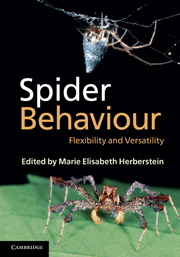Book contents
- Frontmatter
- Contents
- List of contributors
- How this book came about
- 1 Introduction: spider biology
- 2 Flexibility in the foraging strategies of spiders
- 3 Spider webs: evolution, diversity and plasticity
- 4 Flexible use of anti-predator defences
- 5 Communication
- 6 Deceptive signals in spiders
- 7 Mating behaviour and sexual selection
- 8 Group living in spiders: cooperative breeding and coloniality
- 9 Plasticity, learning and cognition
- 10 Kleptoparasitic spiders of the subfamily Argyrodinae: a special case of behavioural plasticity
- Index
- Plate section
- References
4 - Flexible use of anti-predator defences
Published online by Cambridge University Press: 05 June 2012
- Frontmatter
- Contents
- List of contributors
- How this book came about
- 1 Introduction: spider biology
- 2 Flexibility in the foraging strategies of spiders
- 3 Spider webs: evolution, diversity and plasticity
- 4 Flexible use of anti-predator defences
- 5 Communication
- 6 Deceptive signals in spiders
- 7 Mating behaviour and sexual selection
- 8 Group living in spiders: cooperative breeding and coloniality
- 9 Plasticity, learning and cognition
- 10 Kleptoparasitic spiders of the subfamily Argyrodinae: a special case of behavioural plasticity
- Index
- Plate section
- References
Summary
Belonging to a size category that makes them vulnerable to a wide variety of predators, spiders have evolved a bewildering array of anti-predator adaptations, which can be clustered under two broad categories, primary and secondary defence. Primary defences are ploys by which the spider avoids provoking pursuit by, and interaction with, the predator. Camouflage and masquerade are especially common examples. Secondary defences come into play once an interaction with a predator is under way, and these are the defences that have been most thoroughly studied. However, elements of anti-predator defence may often be integrated into other aspects of the spider's biology. Cues from predators may influence a spider's decision to move away from a habitat, and may also influence the decisions spiders make in the context of courtship, mating and oviposition. Anti-predator defences are sometimes subject to local adaptation by different populations within single species, and considerable flexibility in anti-predator ploys may be evident even at the level of the individual spider. Although vertebrates are often predators of spiders, anti-predator flexibility may have evolved primarily when the predator is another spider or an insect. Spider–spider encounters in particular have a way of blurring the distinction between anti-predator and predatory behaviour. Tremendous opportunity remains for research on the anti-predator defences of spiders, but perhaps the major challenge for future researchers will be to devise and carry out experiments that demonstrate the efficacy in the field of anti-predator defences that have thus far been studied primarily in the laboratory.
Information
- Type
- Chapter
- Information
- Spider BehaviourFlexibility and Versatility, pp. 99 - 126Publisher: Cambridge University PressPrint publication year: 2011
References
Accessibility standard: Unknown
Why this information is here
This section outlines the accessibility features of this content - including support for screen readers, full keyboard navigation and high-contrast display options. This may not be relevant for you.Accessibility Information
- 8
- Cited by
